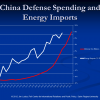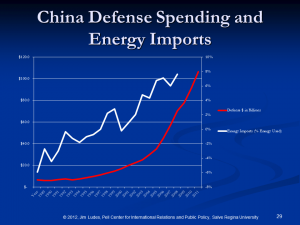Energy Geopolitics: Thinking about China’s Defense Spending
Webster’s defines “geopolitics” as:
- a study of the influence of such factors as geography, economics, and demography on the politics and especially the foreign policy of a state
- a governmental policy guided by geopolitics
- a combination of political and geographic factors relating to something (as a state or particular resources)
And during the Cold War we talked about geopolitics, or so it seemed, with a lot more frequency than we have in recent years.
But competition for energy supplies makes us think about geopolitics.
And here, my mind can’t help but be drawn to China.
A couple of key points from the International Energy Agency:
- 48% of global growth in energy demand between now and 2035 will come from China. In fact, by the end of that time, China is projected to use 170% of the energy that the United States uses.
- While the bulk of that demand for energy will come in the form of energy for industry (read: coal), China’s burgeoning middle class will also consume more and more petroleum.
And here’s where things get a bit provocative on the energy geopolitics front.
Until the mid-1990s, China was a net exporter of energy. But since that time, it has imported more and more of its energy, and those projections only grow.
Out of curiosity, I decided to track China’s defense spending against the percent of its energy that is imported. The above chart depicts the data.
Now as my friend and former colleague Bernard Finel always reminds me, correlation is not causation, but the trend lines here are fascinating for what they suggest about China’s increase in defense spending in relation to its need for foreign sources of energy.


